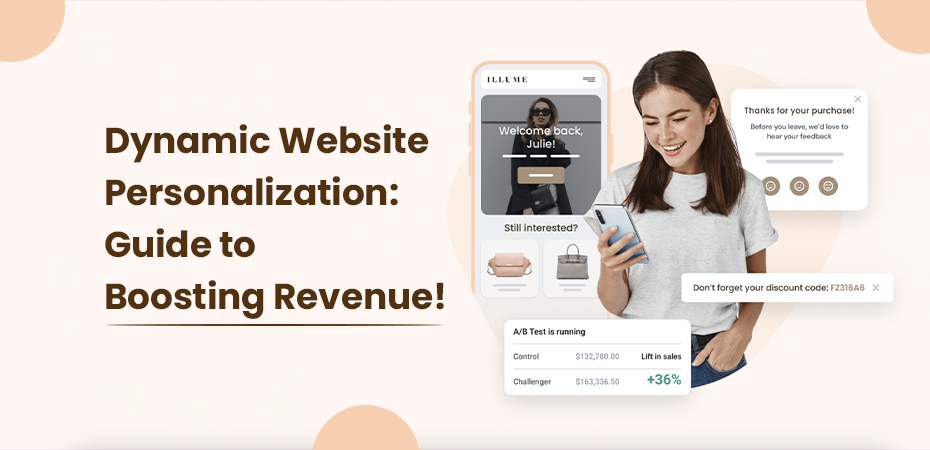Dynamic Website Personalization: Guide to Boosting Revenue



In today’s fast-paced digital world, customers expect more than just a basic website. They want experiences that feel tailored to them—like a store that knows what they love and caters to their preferences. This is where dynamic website personalization comes in.
Dynamic website personalization is the process of creating unique online experiences for each visitor. Instead of showing the same content to everyone, personalization software adapts the website based on a user’s preferences, past behavior, and even their location.
Why does this matter for businesses? Because personalized experiences drive results. Companies that use website personalization tools see higher customer engagement, better conversion rates, and increased revenue. In fact, research shows that businesses using personalized websites can see up to 80% higher conversion rates and 40% more revenue than those using a one-size-fits-all approach.
If you’re looking to grow your business, web personalization is no longer optional—it’s a necessity. Let’s dive deeper into what it is and how it works.
What is Website Personalization?
At its core, website personalization is all about making a website feel personal and relevant to each visitor. It’s like having a personal shopper online who knows your tastes, interests, and needs.
For businesses, this means transforming their websites from static, generic pages into personalization websites that adapt to individual users. This is achieved using personalization tools like Marketo real-time personalization, which gathers data about visitors and uses it to show tailored content.
For example:
- A clothing store might recommend jackets to someone browsing in winter or suggest sandals during summer.
- A news website might highlight sports stories for one user and financial updates for another, depending on their reading history.
- An e-commerce site might showcase products that match a visitor’s recent purchases or items left in their cart.
By delivering these customized experiences, personalization software helps businesses connect with their audience on a deeper level, making visitors feel valued and understood.
Key features of website personalization include:
- Tailored Content: Showing content that matches a user’s interests or preferences.
- Dynamic Recommendations: Using product recommendation tools to suggest items based on past purchases or browsing history.
- Real-Time Adaptation: Adjusting the website as the visitor interacts with it, ensuring the experience feels seamless and natural.
Why Personalized Websites Work
Personalized websites work because they cater to the unique needs and preferences of each visitor. Instead of treating every visitor the same, web personalization tools create experiences that feel relevant and engaging. Here’s why this approach is so effective:
1. Customers Feel Valued
When visitors see a website tailored just for them, it creates a sense of connection. They feel like the brand understands their needs, which builds trust and loyalty.
2. Improved Engagement
Visitors are more likely to spend time on a personalized website because the content resonates with them. Whether it’s product recommendations, location-specific offers, or personalized search results, these tailored elements keep users interested and engaged.
3. Higher Conversions
Web personalization directly impacts sales. By showing the right content at the right time, businesses can guide visitors toward making a purchase. For example, a personalized call-to-action (CTA) can perform up to 202% better than a generic one.
4. Repeat Business
A positive, personalized experience encourages customers to return. Research shows that customers are 40% more likely to make repeat purchases when they feel connected to a brand through customised websites.
In short, website personalisation tools make visitors feel like the website was made just for them—and that makes all the difference.
How Does Website Personalization Work?
Website personalization relies on data to understand each visitor and deliver tailored experiences. This process involves several key steps:
1. Collecting Data
Web personalization tools gather information about visitors through various methods, such as:
- Demographics: Age, gender, language, and location.
- Behavioral Data: What pages they visit, what they click on, and how long they stay.
- Contextual Data: The type of device they’re using, the time of day, or even the weather.
For example, a clothing store might notice that a visitor spends a lot of time looking at sneakers. The next time they visit, the website could highlight sneakers on the homepage.
2. Analyzing the Data
Once the data is collected, personalisation platforms analyze it to identify patterns and preferences. This is where advanced tools like ecommerce personalization software and Marketo website personalization come into play. These platforms use artificial intelligence (AI) and machine learning to process the data quickly and accurately.
3. Creating User Segments
Based on the analysis, visitors are grouped into segments. For example:
- Visitors looking for winter clothing.
- Users who prefer discounts and promotions.
- Repeat customers versus first-time visitors.
This segmentation allows businesses to deliver more relevant content to each group.
4. Delivering Personalized Content
Finally, website personalisation tools use this information to adapt the site in real time. This can include:
- Dynamic Product Recommendations: Highlighting items based on past behavior.
- Customized Layouts: Adjusting the homepage or navigation to suit the user’s preferences.
- Location-Based Offers: Showing discounts specific to the user’s region.
The result? A website that feels intuitive, engaging, and personal for every visitor.
By using personalization platforms effectively, businesses can create personalized websites that boost engagement, drive sales, and build lasting customer relationships.
Benefits of Web Personalization
Web personalization has become a game-changer for businesses, transforming how they interact with customers. By tailoring experiences to individual users, website personalization tools provide a range of benefits that directly impact engagement, sales, and customer loyalty.
1. Increased Engagement
Personalized websites grab attention and hold it longer. When visitors see content and products that match their preferences, they’re more likely to explore further. For example, tailored content keeps users on a page 2.5 times longer than generic content.
2. Higher Conversion Rates
Web personalization tools play a significant role in converting visitors into customers. Personalized calls-to-action (CTAs) and product recommendations create a direct path to purchases. Businesses that use personalized software often see conversion rates triple compared to non-personalized sites.
3. Improved Customer Loyalty
A personalized experience builds trust and loyalty. Customers appreciate when brands understand their needs and deliver relevant offers. This connection increases repeat purchases by 40%, boosting long-term customer value.
4. Better Marketing ROI
By targeting the right audience with tailored content, businesses reduce wasted marketing spend. Web content personalization ensures that campaigns are efficient, improving return on investment (ROI) by up to three times.
5. Enhanced Customer Satisfaction
Personalization makes shopping seamless and enjoyable. Features like product recommendation tools and location-based offers simplify the decision-making process, making customers more satisfied with their experience.
6. Competitive Advantage
In a crowded market, a personalized website sets you apart. Businesses using ecommerce personalization software deliver unique shopping experiences, giving them an edge over competitors who rely on generic websites.
Types of Website Personalization
There are many ways to personalize a website. By using the right website personalization tools, businesses can create experiences tailored to different aspects of a user’s journey. Here are the main types of personalization:
1. Content Personalization
This involves showing specific content based on user preferences, such as:
- Blog posts tailored to a visitor’s interests.
- Dynamic headlines that change based on past behavior.
- Personalized messages welcoming returning customers.
2. Product Recommendations
Product recommendation tools suggest items based on what users have browsed or purchased. This type of personalization is common in e-commerce and is a key feature of the best ecommerce personalization software.
3. Location-Based Personalization
Using geolocation data, websites can show region-specific offers, pricing, or promotions. For example, a website might display warm clothing for visitors in cold regions and summer outfits for those in warmer climates.
4. Behavioral Personalization
By analyzing how visitors interact with a website, businesses can adjust the user experience. For instance:
- Highlighting popular products based on browsing history.
- Offering discounts to users who abandon their shopping carts.
5. Demographic Personalization
This involves tailoring content to a user’s age, gender, or language. For example, a site might offer different designs or recommendations for younger versus older audiences.
6. Device-Specific Personalization
Web personalization tools adapt content for mobile, tablet, or desktop users. A responsive, customized layout ensures a smooth experience, no matter how visitors access the site.
Challenges of Personalizing Websites
While personalization software offers incredible benefits, implementing it can come with challenges. Here are some of the key hurdles businesses face:
1. Data Privacy and Compliance
With strict regulations like GDPR and CCPA, businesses must handle user data carefully. Obtaining explicit consent, ensuring secure storage, and staying compliant with changing laws can be complex.
2. Technical Integration
Integrating website personalization software with existing systems can be challenging, especially for businesses using outdated or incompatible platforms. Real-time data processing also requires advanced technical infrastructure.
3. Content Management
Creating enough content to cater to various user segments is a common struggle. Businesses must regularly update and manage content to ensure it stays relevant and engaging.
4. Data Quality Issues
Inaccurate or incomplete data can undermine personalization platforms. Businesses need to focus on collecting high-quality, real-time data to avoid missteps.
5. Resource Requirements
Implementing and maintaining web personalization tools can require significant investment in software, expertise, and ongoing optimization efforts.
6. Balancing Personalization and Privacy
Visitors value personalization but don’t want to feel like their privacy is invaded. Striking the right balance between delivering tailored experiences and respecting privacy is essential.
How to Start with Web Personalization
Getting started with website personalization can feel overwhelming but breaking it into manageable steps can make the process easier.
1. Set Clear Goals
Decide what you want to achieve. Are you aiming to increase conversions, improve engagement, or boost repeat purchases? Defining your objectives will guide your strategy.
2. Gather Data
Use website personalization tools to collect information about your visitors, such as:
- Demographics: Age, location, and language preferences.
- Behavior: Browsing history, clicks, and purchase patterns.
- Context: Device type, time of visit, and more.
3. Segment Your Audience
Group your visitors into segments based on shared traits. For example, you might create one segment for new visitors and another for returning customers.
4. Choose the Right Tools
Select personalization software that fits your needs and budget. Popular options include Marketo website personalization, Dynamic Yield, and Google Optimize.
5. Start Small
Begin with simple personalization elements, such as product recommendation tools or tailored CTAs. Test these features before expanding your efforts.
6. Measure and Optimize
Track performance metrics like engagement, conversion rates, and revenue. Use these insights to refine your strategy and improve your web customization efforts.
Conclusion
Your website is more than just an online presence—it’s a powerful tool to connect with customers and drive revenue. By investing in web personalization, you can unlock its full potential and deliver experiences that keep visitors coming back.
With the right personalization platform, your business can stand out in a crowded digital world. Whether you’re just starting or looking to enhance your strategy, website personalization software can transform your site into a revenue-generating machine.
Don’t wait to take advantage of the benefits. Start using web personalisation tools today and see the difference a personalized website can make!